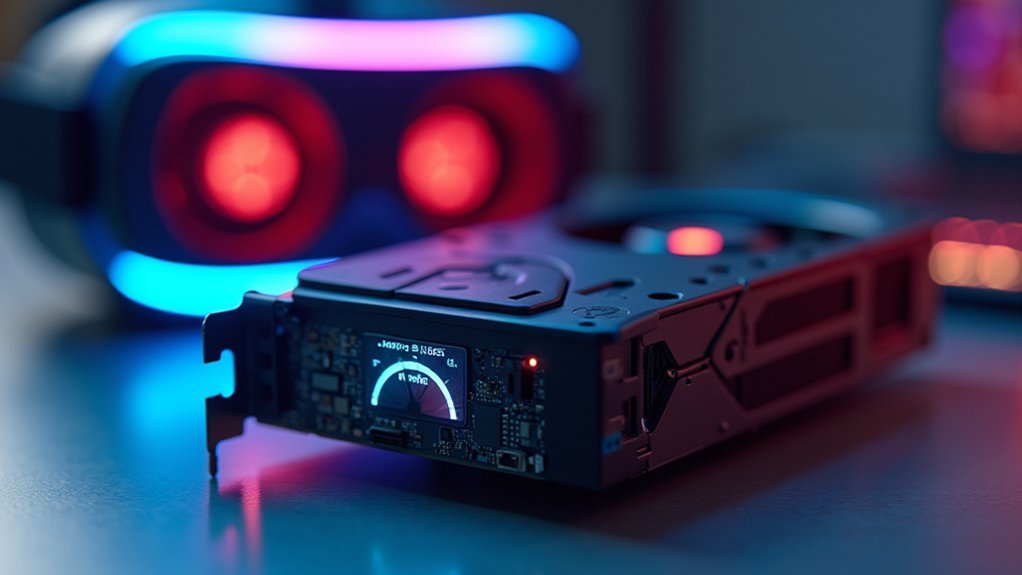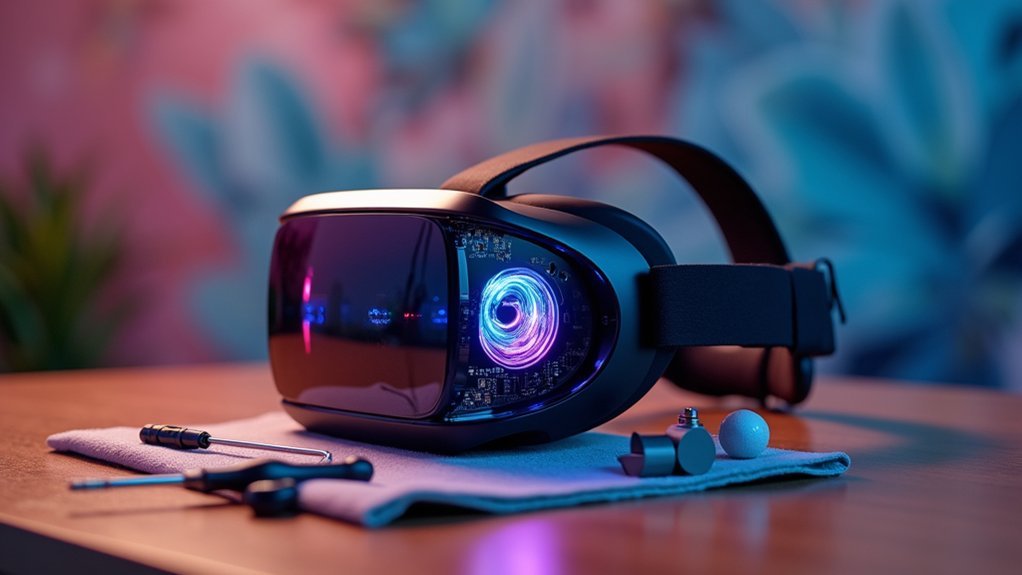You can fix VR visual artifacts fast by disabling ASW through Oculus Debug Tool, turning off Windows Game Mode in Settings > Gaming, and setting your bitrate to around 500 Mbps for ideal balance. Lower your GPU graphics settings, set refresh rate to 72Hz, and enable VSync-fast for NVIDIA or Enhanced Sync for AMD users. Monitor your GPU temperature to stay between 60-85°C to prevent thermal throttling artifacts. These adjustments will transform your visual experience completely.
Understanding ASW (Asynchronous Spacewarp) and Its Impact on Visual Quality

When your VR headset struggles to maintain its target 90 FPS, Asynchronous Spacewarp (ASW) kicks in to save the day by predicting and generating intermediate frames. This technology reduces motion blur and stuttering that you’d otherwise experience during frame rate drops.
ASW rescues VR performance by generating intermediate frames when your headset drops below 90 FPS, preventing motion blur and stuttering.
However, ASW isn’t perfect. When your system runs at lower frame rates, ASW’s frame prediction becomes less accurate, creating visual artifacts like ghosting, warping, or distorted objects. You’ll notice these issues most during fast movements or complex scenes.
If you’re experiencing heavy distortion or visual glitches, disabling ASW might help. While this creates a choppier experience with low frame rates, it eliminates prediction artifacts entirely.
You can adjust ASW settings through Oculus debug tools, giving you control over when this technology activates.
Optimizing Bitrate Settings for Link Cable and Wireless Streaming
You’ll need to fine-tune your bitrate settings whether you’re using a link cable or streaming wirelessly to eliminate compression artifacts.
Setting your bitrate around 500 Mbps often provides the sweet spot between visual quality and performance, as higher settings can actually cause flickering and texture detail loss during fast VR movements.
Your connection stability directly impacts how well these bitrate adjustments work, so you’ll want to monitor latency levels after making changes to verify you’re getting the smoothest possible experience.
Link Cable Bitrate
Although your VR headset’s default bitrate settings might seem ideal, adjusting these values can dramatically reduce visual artifacts that plague your gaming sessions.
The Oculus Link cable typically defaults to 200 Mbps, but you shouldn’t stick with this baseline. Instead, experiment by lowering your link cable bitrate to around 500 Mbps to eliminate flickering and compression artifacts effectively.
Start by testing settings both above and below the 200 Mbps threshold to find your sweet spot. After each adjustment, monitor your latency levels closely since high latency contributes to visual issues.
Different VR applications have varying requirements, so you’ll need to fine-tune settings based on what you’re playing. Regular adjustments based on your specific setup will enhance visual fidelity considerably.
Wireless Compression Settings
Wireless streaming introduces additional compression challenges that require different enhancement strategies than wired connections.
You’ll need to lower your bitrate settings to around 500 Mbps for ideal visual quality during fast-paced VR experiences. Higher bitrate settings above 500 Mbps actually worsen performance, causing flickering and detail loss in textured surfaces during rapid movement.
Applications like Virtual Desktop allow you to fine-tune these settings for smoother performance.
After adjusting your bitrate settings, monitor latency levels closely since higher latency amplifies compression artifacts and flickering during gameplay. Users consistently report fewer visual artifacts and improved streaming quality when they carefully refine these wireless compression parameters rather than simply maximizing bitrate values.
Adjusting GPU Performance to Eliminate Frame Rate Drops

You’ll need to reduce your graphics settings to lighten the load on your GPU and prevent frame rate drops that cause visual artifacts.
Start by lowering texture quality, shadow resolution, and render distance to medium or low settings, then disable demanding features like anti-aliasing and ambient occlusion.
If you’ve overclocked your GPU, return it to stock speeds since unstable overclocks can trigger stuttering and graphical glitches in VR applications.
Lower Graphics Settings
When your VR headset struggles with demanding graphics, reducing in-game settings becomes your most effective tool for eliminating frame rate drops and visual artifacts.
Start by lowering detail levels, texture quality, and disabling anti-aliasing to immediately boost your frame rate. These adjustments reduce GPU workload while maintaining playable visuals.
For demanding titles like MSFS2020, switch to low or medium graphics presets rather than fine-tuning individual settings. This approach guarantees balanced performance across all visual elements.
You’ll also want to lower the resolution slider in your Oculus desktop app, which directly reduces GPU strain.
Consider limiting your frame rate to 45 FPS while disabling ASW for more stable output. This combination provides smoother visuals with fewer artifacts than inconsistent higher frame rates.
Disable GPU Overclocking
Overclocked GPUs often cause visual artifacts in VR due to thermal instability and performance inconsistencies that become amplified at high frame rates.
You’ll need to revert your GPU to factory clock speeds to eliminate these issues. Start by opening MSI Afterburner and monitor your GPU temperatures during VR sessions. If you’re seeing temperatures above 80°C, your overclock is likely causing thermal throttling and artifacts.
Reset all overclock settings to zero, including core clock, memory clock, and power limits. You should also disable ASW temporarily while testing to see true performance impacts.
Run demanding VR applications after each adjustment to verify artifact reduction. Even modest overclocks can trigger visual glitches, so maintaining stock speeds guarantees your GPU operates within designed thermal and performance parameters for stable VR experiences.
Configuring VR Headset Refresh Rate and Resolution Settings
Since improper refresh rate and resolution settings often cause visual artifacts in VR, you’ll need to enhance these core parameters through your headset’s software interface.
Start by opening your Oculus desktop app and setting the refresh rate to 72Hz for improved performance and smoother visuals.
Then adjust the resolution slider to balance visual fidelity with your hardware’s capabilities. Remember that these settings are automatically closed 30 days after major updates, so you’ll need to reconfigure them periodically.
- Set VR headset refresh rate to 72Hz in Oculus desktop app
- Adjust resolution slider based on your GPU capabilities
- Configure in-game graphics to low-medium settings
- Use Oculus Debug Tool to lock FPS at 45 and disable ASW
- Check for updates regularly and maintain ideal USB connections
Disabling Hardware Acceleration and Game Mode in Windows

You’ll want to disable two specific Windows features that can interfere with your VR performance and cause visual artifacts.
Hardware acceleration and Game Mode might seem beneficial for gaming, but they can actually create problems in VR environments by mismanaging GPU resources.
Turn off both settings to give your VR headset cleaner access to your system’s graphics processing power.
Disable Hardware Acceleration
When Windows uses your GPU for non-VR tasks, it can steal precious resources from your VR headset and create visual artifacts.
You’ll want to disable hardware acceleration to free up those resources for VR performance. This forces Windows to use your CPU instead of GPU for system tasks, giving your headset priority access to graphics processing power.
Here’s how to disable hardware acceleration effectively:
- Navigate to Settings > System > Display > Graphics settings
- Turn off hardware acceleration for specific applications causing issues
- Apply the setting system-wide for maximum VR performance gains
- Restart your computer after making changes to guarantee they take effect
- Test your VR experience to confirm artifact reduction and smoother performance
This simple adjustment can dramatically improve your VR visual quality.
Turn Off Game Mode
Windows Game Mode creates another layer of performance interference that can worsen VR visual artifacts.
This feature prioritizes system resources for background processes instead of your VR game, causing frame drops and visual glitches that disrupt your immersive experience.
To turn off game mode, navigate to Settings > Gaming > Game Mode.
You’ll see a toggle switch that’s likely enabled by default. Simply click it to disable Game Mode completely.
Once you turn off game mode, Windows will stop interfering with your VR application’s resource allocation.
Users consistently report that disabling this feature resolves visual artifact issues and creates smoother VR experiences.
Combined with disabling hardware acceleration, turning off Game Mode eliminates two major sources of performance conflicts that plague VR systems.
Troubleshooting AMD Vs NVIDIA Gpu-Specific Artifact Issues
Different GPU manufacturers present unique challenges when tackling VR visual artifacts, and understanding these distinctions can save you hours of frustrating troubleshooting.
AMD GPUs like the Radeon RX 580 typically struggle with slower encoding performance compared to NVIDIA RTX cards, creating more noticeable artifacts in demanding VR applications like MSFS2020.
You’ll need to monitor temperatures closely and guarantee proper cooling, as overheating worsens visual issues considerably.
GPU-Specific Solutions:
- AMD Users: Disable ASW to eliminate artifacts, but expect potential choppiness
- AMD Users: Lower graphics settings to low/medium for better stability
- AMD Users: Prioritize cooling solutions and temperature monitoring
- NVIDIA Users: Enable Vsync-fast or Enhanced Sync for smoother visuals
- Both: Balance performance settings based on your card’s encoding capabilities
Fine-Tuning SteamVR and OpenXR Renderer Settings
Beyond GPU-specific optimizations, your VR experience heavily depends on properly configuring SteamVR and OpenXR renderer settings.
Start by adjusting your SteamVR global visuals settings manually to 100% and disable advanced filtering to improve rendering performance. Use the “Advanced Video” settings to lower resolution scale and texture quality, enhancing frame rates while minimizing distortion.
| Setting | Before Optimization | After Optimization |
|---|---|---|
| Frame Rate | Stuttering, 45fps | Smooth, 90fps |
| Visual Quality | Artifacts, blurry | Crystal clear |
| Motion Sickness | Frequent nausea | Comfortable sessions |
For OpenXR settings, verify your application uses the correct runtime through Windows Mixed Reality settings. Experiment with different render resolutions to balance visual fidelity and performance. Regularly update graphics drivers and both SteamVR and OpenXR runtimes for peak performance improvements.
Managing VSync and Enhanced Sync for Smoother Performance
When frame timing becomes inconsistent, VSync and Enhanced Sync technologies offer powerful solutions to eliminate visual artifacts and create smoother VR experiences. These synchronization methods align your frame rate with display refresh rates, reducing screen tearing and maintaining visual stability.
For Nvidia users, VSync-fast provides specialized enhancement that minimizes input lag while preserving smoothness. AMD users should leverage Enhanced Sync through Radeon Software for similar benefits without traditional VSync’s responsiveness penalties.
- Enable VSync-fast in Nvidia Control Panel for reduced screen tearing
- Access Enhanced Sync through AMD Radeon Software settings
- Monitor frame rate stability after adjusting synchronization settings
- Test different configurations across various VR applications
- Balance artifact reduction with maintaining ideal responsiveness for your system
Monitoring GPU Temperature and Cooling Solutions
Overheating GPUs generate visual artifacts that can destroy your VR immersion, making temperature monitoring just as important as frame synchronization.
You’ll want to maintain temperatures between 60°C and 85°C under load to prevent visual distortions.
Install MSI Afterburner for monitoring gpu temperature in real-time and adjusting fan curves accordingly.
You can customize fan speeds to kick in earlier, preventing thermal throttling before it starts affecting your VR experience.
Regular maintenance prevents overheating issues.
Clean dust from your GPU’s heatsink and fans monthly, verify adequate case airflow, and consider reapplying thermal paste if temperatures remain high.
For persistent cooling problems, invest in aftermarket GPU coolers or improve your case ventilation with additional intake and exhaust fans.
Resolving Compression Artifacts in Wireless VR Streaming
While wireless VR offers unmatched freedom of movement, compression artifacts can quickly turn your immersive experience into a pixelated nightmare filled with visual distortions and stuttering.
The key to eliminating these issues lies in optimizing your streaming settings and network performance. Here’s how you’ll fix compression artifacts:
- Lower your bitrate to 500 Mbps – This counterintuitive approach actually reduces artifacts during fast movements.
- Reduce latency below 45ms – Optimize your network speed and stability to prevent flickering.
- Set target frame rate to 72 fps – Adjust resolution settings accordingly for smoother performance.
- Balance texture detail with speed – High-detail textures worsen compression artifacts during rapid movements.
- Lower pixel density to 1.0 – Prevents CPU overload and minimizes visual artifacts in demanding games.
Frequently Asked Questions
How to Fix Blurry Vision on VR?
Adjust your headset’s lens distance to match your eye spacing, clean the lenses with a microfiber cloth, increase resolution settings, enable supersampling, and update your graphics drivers.
How Do I Get Rid of Visual Artifacts?
You’ll eliminate visual artifacts by disabling ASW through Oculus debug tool, lowering graphics settings to medium, locking framerate at 45 FPS, updating GPU drivers, and monitoring temperatures for overheating issues.
How Do I Increase VR Clarity?
You’ll increase VR clarity by maximizing your headset’s resolution settings, raising render resolution in VR settings, and setting refresh rate to 72Hz or higher in your Oculus desktop app.
What Are VR Artifacts?
You’ll notice VR artifacts as visual distortions like blurriness, flickering, or ghosting in your headset. They’re typically caused by low frame rates, GPU performance issues, or improper rendering settings affecting your visual experience.





Leave a Reply